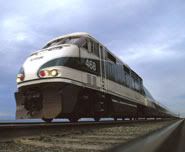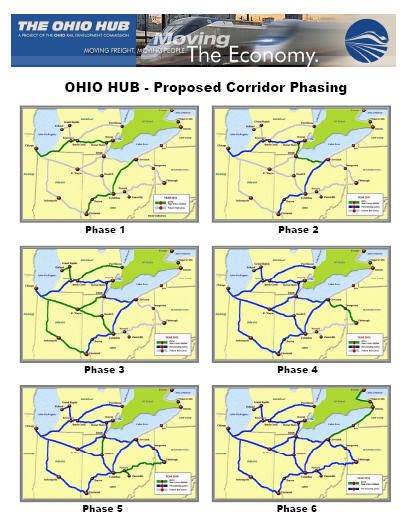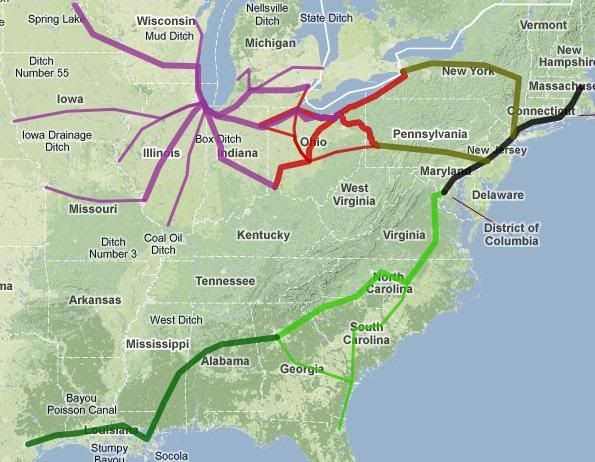 One of the consequences of the 2010 General Elections was the election of RepubliCorp Governors in Ohio and Wisconsin who politically neutralized the success of sitting Democratic state administrations in landing $400m and $800m High Speed Rail funding by demonizing the High Speed projects that were funded.
One of the consequences of the 2010 General Elections was the election of RepubliCorp Governors in Ohio and Wisconsin who politically neutralized the success of sitting Democratic state administrations in landing $400m and $800m High Speed Rail funding by demonizing the High Speed projects that were funded.What that means for Wisconsin seems likely to be cancellation of the project but its certainly worth pushing back (and see below for further).
Ohio was completing the final Design this year, so never committed to the Build funds, so while Kasich is handing ~8,000 jobs to another state, there's no immediate budget impact to hit him with. Indeed, given the new make-up of the state board that would have to approve taking the Build money, after demonizing the "Quickstart", Kasich couldn't take the money now if he wanted to.
So where next for Ohio High Speed Rail?
________________________________________
The Wisconsin Republican Rail Cancellation Boondoggle
Whether stakeholders pulling the string of Wisconsin Gov. Jobs Go Walkabout balk at handing that money back and taking $100m out of the state budget to boot, or whether the Governor sticks to his Modern No-Nothing guns and gets a black eye for the egregious fiscal irresponsibility, its a fight worth fighting.
That is, the cancellation of the Federal Funding for the Madison / Milwaukee rail corridor will cost Wisconsin [http://www.wisgov.state.wi.us/docview.asp?docid=20612 cost $97.65m], versus the commitment to the start up rail subsidy of any amount required up to $7.5m/yr, which was the original promised state contribution to the project.
That promise of a $7.5m annual operating subsidy if required was the basis for the Republican charge that the rail corridor was a boondoggle. Yet canceling the project will cost enough for over three full Governors terms worth of that operating subsidy. And on the other hand, the actual need for the subsidy will drop over its first five years, as patronage is built on the new corridors ... and at the same time, speed upgrades to Milwaukee/Chicago anywhere in that dozen years would surely make allow the Madison / Milwaukee segment of the route to generate an operating surplus.
Why is it necessary to kill these projects?
 And that is what these cancellations are about. It is not a high priority emergency for the Oil Lobby to kill these projects in their cradle because of a risk that they will fail to reach operating surpluses. Its a high priority emergency because of the much greater likelihood that they will succeed in reaching operating surpluses as they reach maximum speeds at or greater than Interstate Highway driving speeds, via raising the maximum corridor speed limits of 110mph and a combination of corridor and equipment that allows the train to be operating between 90mph and 110mph for the bulk of the trip.
And that is what these cancellations are about. It is not a high priority emergency for the Oil Lobby to kill these projects in their cradle because of a risk that they will fail to reach operating surpluses. Its a high priority emergency because of the much greater likelihood that they will succeed in reaching operating surpluses as they reach maximum speeds at or greater than Interstate Highway driving speeds, via raising the maximum corridor speed limits of 110mph and a combination of corridor and equipment that allows the train to be operating between 90mph and 110mph for the bulk of the trip.What operating surpluses means is that advocates can push for operating surpluses to be dedicated to capital improvements of a state network. And then if there happens to be a source of Federal funds requiring a state match, banked operating surpluses can be offered for smaller grants, and revenue bonding can be used to generate state matches for larger grants.
And it is very hard for state legislators to say to constituents, "no, sorry, too expensive" when advocates can say, "oh, just make it self-funding".
Killing a transport system that generates operating surpluses and can provide the state/local matching funds to help finance its own extension and upgrade is something best done before those operating surpluses show up.
But, Wasn't the 3C Going to be a Permanently Subsidized Rail Corridor?
 Ah, so what about the 3C Quickstart? Why did the State Legislature have to promise to provide up to $12m in operating surpluses over the next 20 years in order for the USDoT to give Ohio $400m to build the 3C Quickstart?
Ah, so what about the 3C Quickstart? Why did the State Legislature have to promise to provide up to $12m in operating surpluses over the next 20 years in order for the USDoT to give Ohio $400m to build the 3C Quickstart?The Ohio Hub has always been planned in terms of a 79mph alternative and a 110mph alternative. And those speed are maximum speeds, not averages: a 79mph corridor can have a "transit speed" of 40mph~55mph, while a 110mph can achieve transit speeds of 60mph~80mph.
Population density is important for reaching operating surpluses. But not population density per mile: population density around the corridor stations, per hour travel time. So entirely independent of anything else, that speed upgrade to 110mph improves the demand for the service. And for cities too close together to have a large number of air passengers, "higher speed than driving" means that the service occupies the "high speed" segment of the market as well.
However, the flip side is capital cost. Broadly speaking, the infrastructure for a 110mph level HSR service can be divided into the track, signaling and level crossings required to operate passenger rail at 79mph, the additional track required to operate passenger rail at 110mph, the additional signaling for 80mph+, and the upgraded level crossings for 110mph+. And if you plan ahead, there is little extra cost in doing that by stages: for instance, if the new track required by the 79mph services are built at sufficient distance from the freight track, they will work perfectly well for the 110mph services.
So the idea of the "3C Quickstart" was to apply for enough money to build enough of the 110mph corridor to be able to run 79mph trains. Then over time, it was hoped that the state would be able to get Federal Funds with state matching funds to upgrade that corridor to 110mph. And once enough of it was upgraded, the schedule could be upgraded, additional services provided with the same number of trains, the system would hit operating break even, and attention could turn to the next stage of the Ohio Hub.
The Achilles Heel of the 3C Quickstart Strategy
Now, the Quickstart strategy was fine-tuned for the fact that $8b in no-match HSR money was in the offing. With the filling in of population in the middle of the 3C corridor since the Penn Central bankruptcy, which killed the prior passenger rail service, Ohio would be getting a quite substantial number of passenger-miles for less than the cost of its highway mowing budget.
And with $8b in the offing, Ohio could not hope to get the 3C corridor built as a 110mph corridor from the outset. That would cost between $1b and $1.5b, and 1/8th to 1/5th of the total national appropriation for a Rapid Rail level HSR corridor would be overly ambitious.
But opting for the "Quickstart" strategy opened the proposal up to partisan attack at the outset. The preliminary timetabling by Amtrak, had a transit speed of ~40mph ... widely publicized as 39mph to benefit from the "$3.99 magic number" effect ... and partisan opposition seized on that number to argue that it was a useless waste of money. Of course the final Design timetable has turned out to be substantially faster than that, at over 50mph ... but as unimpressive as 50mph+ sounds, that had very little hope of being heard over the din of a state gubernatorial election campaign.
Independent of the technical merits and demerits of the 3C Quickstart strategy, it has been successfully demonized, and a different line of attack will be required next time.
The 2C to 3C Strategy.
 The 3C rail corridor is very much a corridor of two halves. As [http://www.thetransportpolitic.com/2010/11/04/understanding-representative-john-micas-transportation-agenda/#comment-102003 Drewski comments at The Transport Politic]:
The 3C rail corridor is very much a corridor of two halves. As [http://www.thetransportpolitic.com/2010/11/04/understanding-representative-john-micas-transportation-agenda/#comment-102003 Drewski comments at The Transport Politic]: You don’t know much about the 3C corridor. The northern half of the 3C–Cleveland to Columbus–has great bones. It has good gradient, most freight traffic is on a parallel line to the west, and there’s strong traffic volume. If the 3C were funded for a first phase only between Cleveland and Columbus, the planned number of trainsets would’ve allowed for at least 7, maybe 9 or even 10 roundtrips per day. Also, remember that Cleveland-Hopkins is one of a very few American airports located on an existing rail corridor already identified for HSR potential. Adding a station at Crestline would’ve opened up connection to north central Ohio without wrecking the schedule.
The problem really lies with the alignment south of Dayton. The track is in poor condition, both the existing trackbed and the alignment. In honesty, this corridor might be better viewed as a strong conventional line, but true HSR might do better by using a largely abandoned r/w which runs southwest from Columbus, roughly parallel to I-71. Ultimately, at average speeds of 125-150 mph, the schedule from Cinci to Cleveland would allow for a 2-hour trip time or less.
Of course, there are two reasons this will only be a concept. One is that stopping the 3C at Columbus would be politically unacceptable to both southern Ohio and the state GOP (which is based in Cincinnati’s northern suburbs). The other is that incoming Gov. Kasich is hell-bent on killing this plan. Yet another example of Ohio becoming a shadow of its past.
Now, as far as bipartisanship, the Ohio State Republicans have pissed in that particular punch bowl. Any construction over the next ten years will start because the Ohio State Democratic party has gained the clout to push it through. So take that as the outset. And then remember why the Republicans had to be so creative in Gerrymandering Franklin Country (Columbus) and even then lost one and nearly two of their three gerrymanders in Democratic wave elections: swing Central Ohio and you swing the state.
A partisan advantage will be temporary unless it is parlayed into results. So we have to be ready to strike at any time. And the above should inform the planning ahead:
- Give Columbus a 110mph rail service, to somewhere, no matter what else happens in Stage 1
That means Stage 1A of the Ohio Hub includes 110mph Cleveland/Columbus: strictly speaking, 79mph Cleveland Lakefront to Berea, then 110mph to Columbus.
What else? There are a package of "Stage 1B" improvements that can be spread through the state:
- We will have a conventional rail corridor design for Dayton / Cincinnati, and with Cincinnati / Dayton at 1:36 or better on a three stop schedule, that is a 1:50 schedule even with additional stops. So a conventional rail corridor can be established with hourly service each way on the basis of basically two commuter trains and a spare.
- Finalizing the preferred Youngstown alignment of Pittsburgh / Cleveland can put the Capital Corridor through Youngstown / Warren / Portage County / Summit County / Cleveland
- Building the Toledo / Detroit link allows the Cleveland and Toledo to benefit from the ongoing upgrades to the Wolverine line in Michigan.
So, what good is that?
The State of Ohio (somehow) comes up with the operating subsidy to extend one Wolverine each way on the Erie Lakeshore to Pittsburgh, and to connect the Pennsylvanian through to Detroit. This gives one daytime and one evening connection to through Pittsburgh / Cleveland / Toledo / Detroit each way, with one running through to Chicago and one running through to New York.
The State of Ohio also needs to offer the required state subsidy to keep a Dayton/Cincinnati conventional passenger rail service operating. In formal transport terms, this conventional rail service is "independent utility" for a corridor developed looking ahead to linking up with the "2C" corridor. In political terms, this conventional rail service is a hostage: take away the Lakefront funding and lose the Cincinnati/Dayton commuter train.
And finally, the 110mph Cleveland / Columbus service. As the 110mph Cleveland/Columbus schedule from the Ohio Hub is 1:50, and the 110mph Cleveland / Youngstown is 1:17, I will assume that the 79mph Cleveland / Youngstown can operate in 1:50 as well. Then, with the three trains, the following seems possible (note that Youngstown / Warren / Portage County / Summit County also have one additional daytime, one additional evening and two late night connections to Cleveland per day each way via the Erie Lakeshore corridor):
- Northbound
- Columbus 6:50 / Cleveland 8:40
- Columbus 9:20 / Cleveland 11:10
- Columbus 10:50 / Cleveland 12:40
- Columbus 11:50 / Cleveland 13:40
- Columbus 13:50 / Cleveland 15:40
- Columbus 15:50 / Cleveland 17:40 / Youngstown 19:30
- Columbus 17:20 / Cleveland 19:10
- Columbus 19:40 / Cleveland 21:20 / Youngstown 23:10 x
- Columbus 21:20 / Cleveland 23:10 x
- Southbound
- Cleveland 6:50 / Columbus 8:40
- Youngstown 6:50 / Cleveland 8:40 / Columbus 10:30
- Cleveland 9:20 / Columbus 11:10
- Cleveland 11:50 / Columbus 13:40
- Cleveland 13:20 / Columbus 15:10
- Cleveland 14:50 / Columbus 16:40
- Cleveland 17:20 / Columbus 19:10
- Cleveland 19:20 / Columbus 21:10
- Youngstown 19:40 / Cleveland 21:20 / Columbus 23:10 x
This is only a notional schedule, and a detailed timetable for the Erie Lakeshore service would have to be determined to ensure convenient transfers with sufficient leeway for reliability ... but it gives an idea of the opportunity. Obviously if there are certain services in higher demand than others, Senior Citizen, Family, and Student discounted fares can be focused on the services that would otherwise have empty seats.
Cost? ... What Benefit do you want?
The Cost of each segment of the plan will go up with the pursuit of stronger benefit.
For example, the cost of the Cincinnati leg is heavily influence by the way that the corridor arrives in downtown. If it operates along the Boathouse alignment, slightly east of downtown along the waterfront, then extending the Streetcar out along to reach a Boathouse terminal station is cheaper than extending the heavy rail to terminate by the downtown transit terminal (which was deliberately designed to prevent use as a heavy rail station). If it operates along the Cincinnati Union Station alignment, then terminating north of the Cincinnati Union Station would be cheapest, perhaps by extending the Streetcar via the never-used Subway and operating as a Rapid Streetcar to reach the terminal. Terminating at Cincinnati Union Station, including works to avoid interfering with the heavy freight traffic in that section of the corridor would cost more, and extending from Cincinnati Union Station to terminate just west of the downtown transit terminal would be still more expensive.
I've already indicated my preference on that front: have Hamilton County vote on it, and do that. As far as the cost, the faster the access the closer to downtown, the better the patronage of the corridor, so capital investment up front will reduce the operating subsidy required.
For the northern Pittsburgh/Detroit corridor, the biggest bottleneck is the lack of a connection at all between Detroit and Toledo. Then improvements on the lightly used branch line connecting Youngstown to Cleveland to allow Cleveland/Youngstown service to mirror 110mph Cleveland/Columbus times. Then improvements between Cleveland and Toledo to improve reliability of both the daytime Erie Lakeshore and the overnight Capital Corridor service. Then upgrade of the Cleveland/Toledo section to 110mph. Then upgrade of the Cleveland/Youngstown corridor to 110mph. Then upgrade of the Youngstown/Pittsburgh corridor to 110mph.
Phasing of Stage One
110mph Cleveland to Columbus first. Then Toledo / Detroit. Then all that other stuff: at the same time if possible, in sequence if not.
This is, after all, about funding in a Ohio state administration four to eight years in the future, under an unknown White House, and unknown combination of Ohio Legislative and Congressional majorities and, therefore, unknown Federal HSR funding levels and unknown Federal/State matching fund splits.
But there are a number of things that are clear:
- There will be at least one and possibly more 110mph Rapid Passenger Rail corridors operating somewhere on our side of the Appalachian Mountains before this comes into the frame ~ it won't be seen as "just for the East Coast" anymore
- There will have been one and maybe more oil price shocks between now and then, since more oil price shocks are coming.
So assuming that the 2010 electoral victories spells long term postponement of HSR projects would be silly. Sometime down the track, there will be an opportunity, and Ohio progressives need to be beating the drum on "why do Republicans insist Ohio cannot have the good stuff other states have" so that campaigning on restoring the HSR program and providing "real faster-than-driving HSR" is the path of least resistance for the Ohio Democratic Party.
Stage Two: Connect to Cincinnati
With this system in place, then the incremental completion of the 3C corridor is straightforward. Sooner or later, the Cleveland/Columbus route will hit break-even, and to prepare for that day, the initial legislation that launches the project dedicates future operating surpluses to capital funding for completion of the 3C. If need be, that would include finishing the Cincinnati / Dayton conventional passenger rail corridor first.
Then the 110mph Columbus/Dayton link is completed. That enables the first full 3C services to run, albeit at conventional rail speeds between Dayton and Cincinnati, picking up the role of a Limited Flyer between Cincinnati and Dayton, supplemented by the conventional passenger services.
Stage Three: The Crystal Ball gets cloudy
Then where to next? From here, I would depart from the Ohio Hub script. I firmly believe by the time we get to the point of Stage Three ~ which is, after all, 2018 or later ~ there will already be momentum for a 220mph or faster HSR corridor between New York and Chicago. And the direct route for a 220mph HSR corridor or faster between Chicago and New York is the Fort Wayne alignment, then across the middle of Northern Ohio, then across Northern Pennsylvania on a general I-80 alignment to New York. Looking at that, and given State of Ohio and State of Pennsylvania balance of power politics, I would not be surprised if the 220mph corridor is pulled down from central PA to connect into Pittsburgh, then run along the old National alignment to Columbus, and then up to the Fort Wayne alignment.
With the routes already sketched above, a Toledo / Fort Wayne corridor would connect the Express HSR alignment to the Erie Lakeshore and to Detroit, while 110mph connection from midway along the Columbus / Dayton to Indianapolis would Connect Indianapolis into the Express HSR system via Rapid Rail HSR corridors to Chicago and Columbus.
But suppose that the Express HSR is actually through the center of northern Ohio? That implies a different alignment for the Ohio Hub Stage 3.
And supposed that the Express HSR is actually generally along an I-80 alignment all the way, so that it runs along the Lakeshore. That implies a different alignment for the Ohio Hub Stage 3 as well.
So given that, I'll worry about about Stage 3 if I should live so long.
Conclusions ...
Conclusions? Aint no ending here. We are not at the end. We are not at the beginning of the end. We are not even at the end of the beginning.
We have, in other words, just begun to fight.
Midnight Oil ~ Blue Sky Mining
If I yell out at night there's a reply of blue silence
The screen is no comfort I can't speak my sentence
They blew the lights at heaven's gate and I don't know why
But if I work all day on the blue sky mine
(There'll be food on the table tonight)
Still I walk up and down on the blue sky mine
(There'll be pay in your pocket tonight)


5 comments:
Fight, fight, fight--great words, but how do you do so? I tried it myself about 20 years ago, and got nothing for it but insults. No light rail line, no tourist rail service, instead we got a dinosaur road and gas going back up to $4 per gallon. I feel I wasted my efforts, at least up till now.
We have the big money institutions (oil, highway building, auto building, auto insurance) people against us. Politicians who could help are either cave men or cowards. How do we prevail against this?
Keep hammering until cracks appear, and then hammer to widen the cracks.
Its been no steps forward, take this planning study funding as a consolation prize, for over a decade. Then the chance of getting HSR started was seized when $8b in DoT discretionary spending in the ARRA was dedicated to HSR in conference.
So even if Gov. Strickland did not end up surviving the negative impact of Ohio unemployment, and even if the Republicorp seized the chance to get a Wall Street investment banker installed as Governor, there is still likely to be a Rapid Rail HSR system in Illinois, up and running before the next gubernatorial election.
As Michiavelli said, "It must be considered that there is nothing more difficult to carry out nor more doubtful of success nor more dangerous to handle than to initiate a new order of things; for the reformer has enemies in all those who profit by the old order, and only lukewarm defenders in all those who would profit by the new order; this lukewarmness arising partly from the incredulity of mankind who does not truly believe in anything new until they actually have experience of it. " ... the signal achievement of the ARRA HSR funding will be to create some actual systems that will allow people to get a taste of what it is and what difference it makes.
Làm sao để tìm dịch vụ van chuyen hang di Da Nang hoặc nơi nhận chuyển hàng đi Hà Nội. Vậy thì hãy liên hệ với Proship chúng tôi. Với các dịch vụ đang cung cấp hiện nay của chúng tôi như dịch vụ ship hàng tại hà nội, cho thuê kho bãi, cho thuê đất trống, chuyển phát nhanh trong nước, ship hàng nội thành tphcm, dịch vụ ký gửi hàng hóa, dịch vụ bốc xếp, cho thuê kho quận 10. Đảm bảo khi đến với chúng tôi bạn sẽ hài lòng vì chúng tôi có tất cả các dịch vụ vận chuyển lưu trữ mà bạn đang cần.
Hi,
This was an excellent post and was very insightful.You have done really very good site. Great work, great site.Your site offers valuable information and good looking.I am very impressed to watch your site.I hope that you can improve. Success you will wait the next day. Ohio jobsHi,
Thuốc cường dương Ngựa Thái là một trong những sản phẩm hỗ trợ sinh lý nam được các quý ông săn đón nhất trong thời gian gần đây. Sử dụng viên cường dương ngựa thái giúp quý ông lâm trận đạt được phong độ tốt nhất, mạnh mẽ, dẻo dai, tràn đầy hưng phấn, làm thỏa mãn bản thân và bạn tình.
Post a Comment